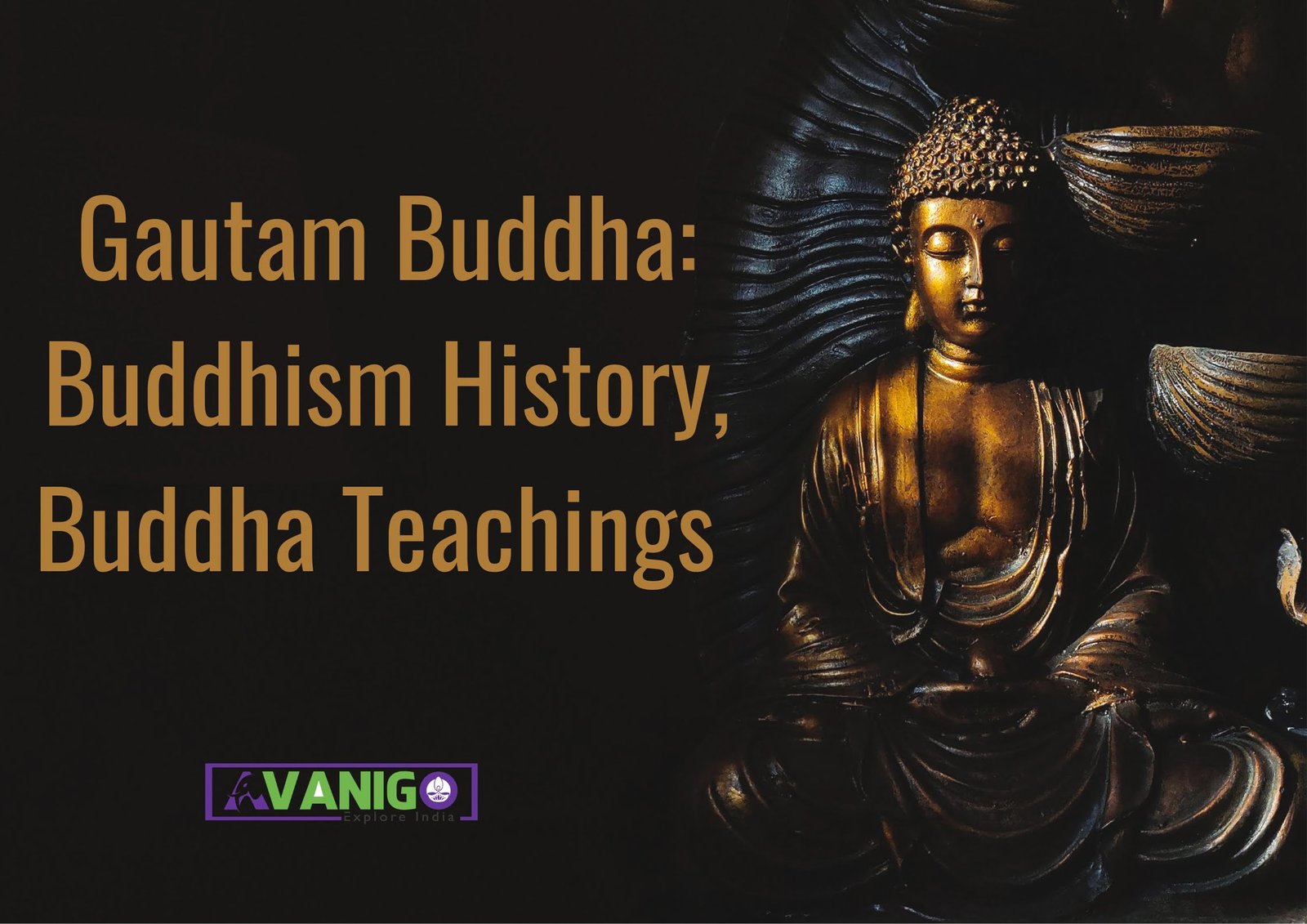Gautam Buddha is commonly referred to as Lord Buddha or The Buddha. He was a revered and devout leader from ancient India. Buddhists use this word to describe people who have reached enlightenment and found their way to freedom again. For 45 years, Buddha carried out the propagation of Buddhism all by himself.
He based his lessons on his deep understanding of how to stop pain and be happy, which led to a state called Nirvana. Gautam Buddha is famous around the world as a well-known religious figure and speaker. He served as a proponent of peace and harmony. Read on to learn everything about Buddhism’s history, Buddha’s teachings and many more.
Quick Navigation
Who was the Founder of Buddhism?
“The Buddha,” Siddhartha Gautama, founded Buddhism in the 5th century B.C. Prince Gautama was born in Nepal to a wealthy and noble family. Gautama got affected by global misery despite his affluent existence.
He decided to relinquish his extravagant way of living and endure poverty. Historians and legends say that Gautam Buddha got enlightenment after 6 years of meditation under a Bodhi tree. After attaining Nirvana, he spent his life teaching people about spirituality and how one can attain it.
History of Gautam Buddha
Gautama Buddha was born in the province of Lumbini in Southern Nepal in 623 BC. He came from a noble family in the Shakya Clan, which is in the foothills of the Himalayas.
Suddhodana was the head of the Shakya clan, which was his father’s job. His mother, Maya, was a princess from the Koliyan community. So, back in the day, the court astrologers predicted that this person would become a super wise sage or even a Buddha.
Did you know that Buddha grew up in a sheltered environment? His father made sure to protect him from the harsh realities of the outside world and human suffering. As a result, Buddha enjoyed a life of luxury. Buddha gained insight into the world after a period of 29 years of living a sheltered and opulent lifestyle.
Buddha was walking through the streets of Kapilavastu when he saw an old, sick, and dead person. The charioteer provided an explanation to him that all entities are susceptible to ageing, illness, and mortality. Upon receiving this information, Buddha was unable to find peace.
On his way back, he observed an itinerant ascetic strolling the thoroughfare. He realizes that through asceticism, they could get past their pain. As a result, they made the decision to leave their kingdom in pursuit of solutions to the issue of suffering.
Suggested Reading: Krishna Govardhana giri story from Bhagavatam
Teachings of Buddha
During his talk, he talked about the Noble Eightfold Path as a way to get rid of wants and reach full control. The initial three pathways delineate how an individual may attain physical mastery. The following two paths demonstrated the means to attain complete mental mastery. He described the paths above to help people reach their highest level of intelligence.
The paths mentioned above are commonly referred to as Eightfold Path, which includes
- Right Understanding
- Right Thought
- Right Speech
- Right Action
- Right Livelihood
- Right Effort
- Right Mindfulness, and
- Right Concentration.
During his life, Gautam Buddha did many spiritual practices and had many important personal events. He understood that life is full of pain and lessons for any human being. Out of his experience, he created some life lessons as below:
- The ultimate goal of the human soul is to attain liberation.
- The understanding of the four Noble truths is essential for achieving salvation in life.
- Enduring hardship is a serious matter as it can bring about personal growth and self-discovery.
- Adhere to the Noble Eightfold Path.
- Death is inevitable, as all living beings are subject to expiration. Furthermore, he advised to focus on the spiritual journey over seeking external validation.
The person said that suffering alone is not enough to bring happiness and freedom from ties to the world. Additionally, he defined the ultimate goal as Nirvana. Per his teachings, adhering to proper modes of thinking, behaviour, lifestyle, focus, and so forth can result in achieving said state. His teachings represent the most exemplary philosophical thoughts that one can adhere to.
Types of Buddhism
In today’s time, people around the globe practise various types of Buddhism. Three primary categories represent distinct geographical regions, :
- Theravada Buddhism: is mainly observed in Thailand, Sri Lanka, Cambodia, Laos, and Burma.
- Mahayana Buddhism: is widely practised in countries such as China, Japan, Taiwan, Korea, Singapore, and Vietnam.
- Tibetan Buddhism: it’s popular in places like Tibet, Nepal, Mongolia, Bhutan, and some parts of Russia and northern India.
Four Noble Truths of Buddhism
The four noble truths of Buddhism hold a central position in the Theravada tradition. All schools of Buddhism acknowledge these to illuminate the fundamental principles of the Buddha’s teachings. Buddha taught that there are four great truths:
● The reality of pain (dukkha)
The term “dukkha” does not refer to severe pain or trauma. This concept includes our mortality and constant yearning for people, things, and emotions. Samsara is not a physical location but a psychological state characterised by perpetual discontentment and discomfort. Temporary relief from cravings and dissatisfaction is often short-lived, as they tend to resurface shortly after that.
● The real reason why people suffer (samudaya)
Once we see that pain is real, we can see what makes it happen. The Buddha taught us that our deeds (karma) and our evil thoughts and feelings make us suffer. It’s easy to credit our problems to other people or situations. Gautam Buddha said that only our thoughts and Karma will determine our happiness or sadness.
● The truth about pain ending (nirhodha)
The Truth of Cessation is that the things that cause pain and unhappiness in Samsara will stop. Buddhahood, or the awakened state, is the state of being completely free from ignorance and attachment. It is a state of peace where thoughts and feelings of pain and suffering will never come up again.
● The reality of the way out of pain (magga)
The Noble Eightfold Path, which is how Buddhists get to the end of pain, is described in the Fourth Noble Truth.
Suggested Reading: Pythagoras Contributions to Mathematics
Holy Book of Buddhism
Buddhists venerate several holy books and scriptures. Among the most significant are:
- Tipitaka: it is the oldest body of Buddhist literature and known as the “three baskets.
- Sutras: More than 2,000 sutras exist. Mahayana Buddhists follow these holy teachings.
- The Book of the Dead: this book is a Tibetan book that describes the phases of death.
Suggested Reading: Statue of Equality in Hyderabad Fascinating Facts
History of Buddhism
Buddhism’s history dates back to sixth century BCE. When Buddha Siddhartha Gautama, its founder was born, Buddhism has taken the birth. Since then, it has been spreading and existing even till date. Buddhism is infact one of the oldest religions in the world.
During its evolution, Buddhism has undergone transformation at various aspects. However, the essence remains the same. Even today, in the parts of Greece, Central Asia, East Asia, and Southeast Asia Buddhism still has strong roots..
Years by year, Buddhism expanded and changed the Asian continent from time to time. The different Buddhist groups, such as Theravada, Mahayana, and Vajrayana, are the most important part of Buddhism’s past.
Buddhist Holidays
Here are the three major Buddhist holidays:
- Vesak, also referred to as the Buddha’s birthday, is a prominent festival celebrated. The celebration occurs on the first full moon day of the fourth lunar month, in May or June.
- Uposatha is an important day of observance that occurs four times a month, on the new, complete, and quarter moon days.
- Bodhi Day is a holiday that observes the day when the historical Buddha attained enlightenment.
FAQs
Who is Buddha?
Buddha is the founder of Buddhism. Buddha is the sixth avatar of Lord Vishnu.
Types of Buddhism?
Theravada Buddhism
Mahayana Buddhism
Tibetan Buddhism
Buddha Real Name?
Siddhartha Gautama
Impact of Buddhism?
Buddhism is known for its love and peace messages.
Gautam Buddha Meditation?
Is done in Bodh Gaya, Bihar, India.

